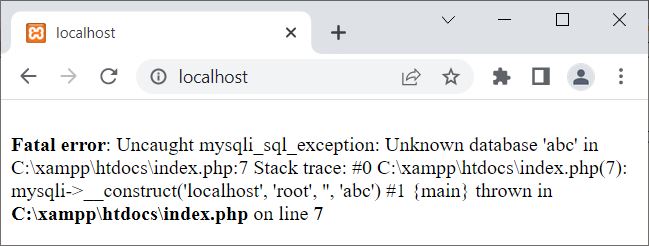- PHP Basics
- Learn PHP
- PHP Comments
- PHP Data Types
- PHP Variables
- PHP Operators
- PHP echo
- PHP print
- PHP echo vs. print
- PHP if else
- PHP switch
- PHP for Loop
- PHP while Loop
- PHP do...while Loop
- PHP foreach Loop
- PHP break and continue
- PHP exit()
- PHP exit() vs. break
- PHP isset()
- PHP Arrays
- PHP print_r()
- PHP unset()
- PHP Strings
- PHP Functions
- PHP File Handling
- PHP File Handling
- PHP Open File
- PHP Create a File
- PHP Write to File
- PHP Read File
- PHP feof()
- PHP fgetc()
- PHP fgets()
- PHP Close File
- PHP Delete File
- PHP Append to File
- PHP Copy File
- PHP file_get_contents()
- PHP file_put_contents()
- PHP file_exists()
- PHP filesize()
- PHP Rename File
- PHP fseek()
- PHP ftell()
- PHP rewind()
- PHP disk_free_space()
- PHP disk_total_space()
- PHP Create Directory
- PHP Remove Directory
- PHP Get Files/Directories
- PHP Get filename
- PHP Get Path
- PHP filemtime()
- PHP file()
- PHP include()
- PHP require()
- PHP include() vs. require()
- PHP mysqli Tutorial
- PHP mysqli Tutorial
- PHP and MySQL Setup
- PHP mysqli: Create Database
- PHP mysqli: Create Table
- PHP mysqli: Insert Record
- PHP mysqli: Update Record
- PHP mysqli: Fetch Record
- PHP mysqli: Delete Record
- PHP mysqli: SignUp Page
- PHP mysqli: LogIn Page
- PHP mysqli: Store User Data
- PHP mysqli Functions
- PHP mysqli_connect()
- PHP mysqli_close()
- PHP mysqli_connect_errno()
- PHP mysqli_connect_error()
- PHP mysqli_query()
- PHP mysqli_fetch_row()
- PHP mysqli_fetch_assoc()
- PHP mysqli_fetch_array()
- PHP mysqli_free_result()
- PHP mysqli_error()
- PHP mysqli_prepare()
- PHP mysqli_stmt_bind_param()
- PHP mysqli_stmt_execute()
- PHP mysqli_stmt_fetch()
- PHP mysqli_stmt_store_result()
- PHP mysqli_stmt_num_rows()
- PHP mysqli_stmt_bind_result()
- PHP mysqli_stmt_get_result()
- PHP mysqli_result class
- PHP mysqli_report()
- PHP error_reporting()
- PHP mysqli_real_escape_string()
- PHP htmlspecialchars()
- PHP Misc Topics
- PHP Object Oriented
- PHP new Keyword
- PHP header()
- PHP getallheaders()
- PHP Cookies
- PHP Sessions
- PHP Date and Time
- PHP GET vs. POST
- PHP File Upload
- PHP Image Processing
PHP mysqli_driver() and mysqli_report()
This article is created to cover the two functions of PHP, namely:
Both functions are used to modify the error reporting mode. The only difference is that mysqli_driver() uses PHP mysqli object-oriented script, whereas mysqli_report() uses PHP mysqli procedural script.
PHP mysqli_driver()
When we want to change the error reporting mode in an object-oriented way, we use the PHP mysqli_driver() function. For example:
<?php
$driver = new mysqli_driver();
$driver -> report_mode = MYSQLI_REPORT_OFF;
$server = "localhost";
$user = "root";
$pass = "";
$db = "abc";
$conn = @new mysqli($server, $user, $pass, $db);
if($conn -> connect_errno)
{
echo "Database connection failed.";
echo "<BR>";
echo "Error Code: ", $conn -> connect_errno;
exit();
}
else
{
echo "Connection established successfully!";
// block of code to process further
}
$conn -> close();
?>
Since the database abc is not available on my MySQL database server. Therefore, the output of the above example is:

Note: The @ symbol was used before new mysqli() to suppress the default error.
Without the following two statements, in the above example:
$driver = new mysqli_driver(); $driver -> report_mode = MYSQLI_REPORT_OFF;
The output should be:

That is, using the new keyword, an object named $driver of class mysqli_driver() is created. And using the object $driver, I have changed the value of report_mode to MYSQLI_REPORT_OFF to turn off the error reporting.
Note: The mysqli() function is used to open a connection to the MySQL database server in object-oriented style.
Note: The new keyword is used to create a new object.
Note: The connect_errno is used to get or return the error code (if any) from the last connect call in object-oriented style.
Note: The close() function is used to close an opened connection in object-oriented style.
PHP mysqli_driver() Syntax
The syntax of the mysqli_driver() function in PHP is:
$mysqli_driver -> report_mode;
That is:
$mysqli_driver = new mysqli_driver(); $mysqli_driver -> report_mode = flag;
Based on the flag, error reporting mode is set to exception, warning, or none. Here is the list of flags that can be used:
- MYSQLI_REPORT_ALL: Used to report all errors.
- MYSQLI_REPORT_OFF: Used to turn off error reporting.
- MYSQLI_REPORT_ERROR: Used to report error from mysqli() function call.
- MYSQLI_REPORT_INDEX: Used to report errors only when no or a bad index is used in a query.
- MYSQLI_REPORT_STRICT: Used to throw mysqli_sql_exception for errors instead of warnings.
PHP mysqli_report()
When we need to change the error reporting mode in a procedural way, we use the PHP mysqli_report() function. For example:
<?php
mysqli_report(MYSQLI_REPORT_OFF);
$server = "localhost";
$user = "root";
$pass = "";
$db = "abc";
$conn = @mysqli_connect($server, $user, $pass, $db);
if(mysqli_connect_errno())
{
echo "Database connection failed.";
echo "<BR>";
echo "Error Code: ", mysqli_connect_errno();
exit();
}
else
{
echo "Connection established successfully!";
// block of code to process further
}
mysqli_close($conn);
?>
Note: The mysqli_connect() function is used to open a connection to the MySQL database server in procedural style.
Note: The mysqli_connect_errno() function is used to get or return the error code (if any) from the last connect call in procedural style.
Note: The mysqli_close() function is used to close an opened connection to the MySQL database in procedural style.
PHP mysqli_report() Syntax
The syntax of the mysqli_report() function in PHP is:
mysqli_report(flag);
« Previous Tutorial Next Tutorial »